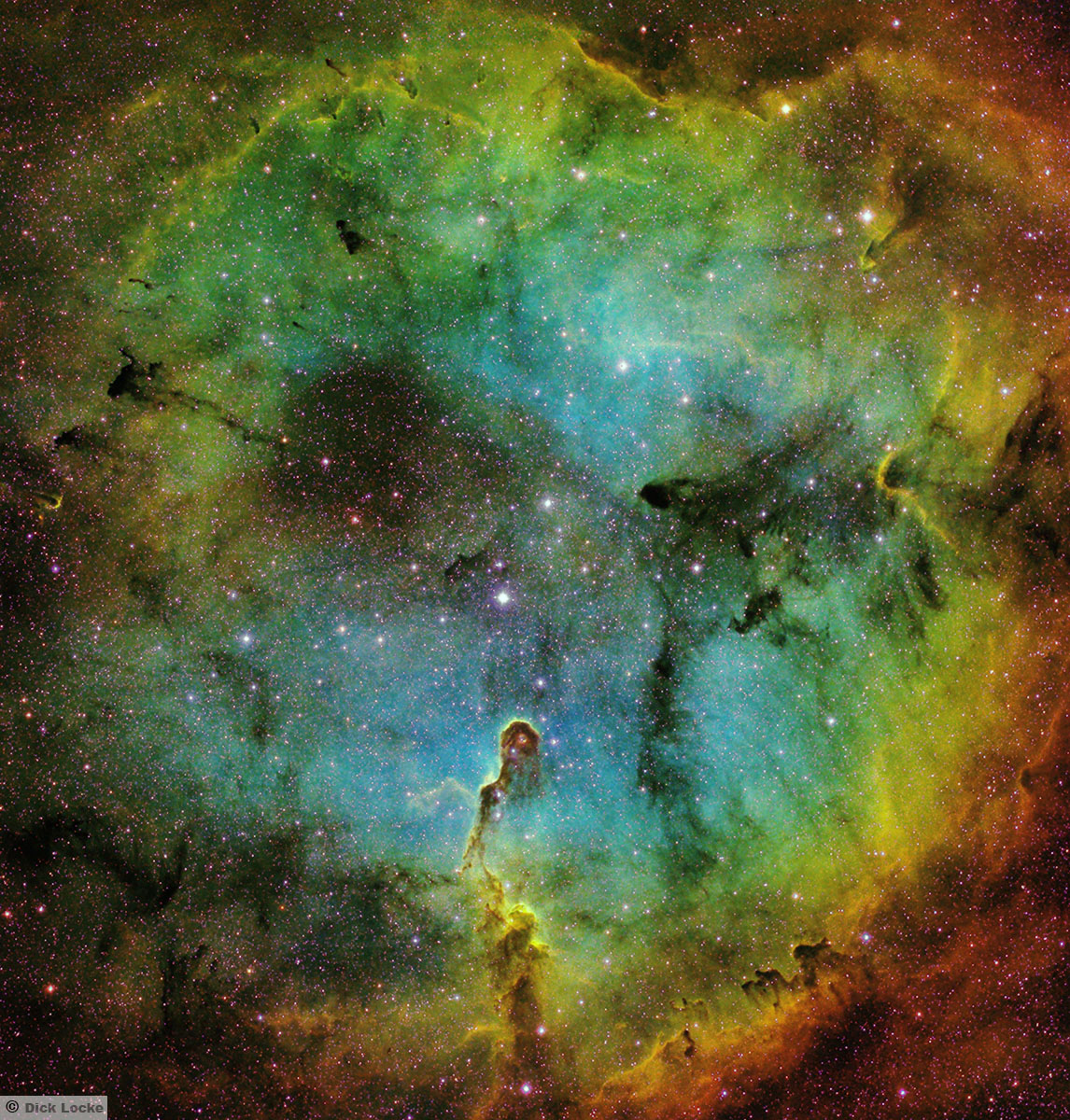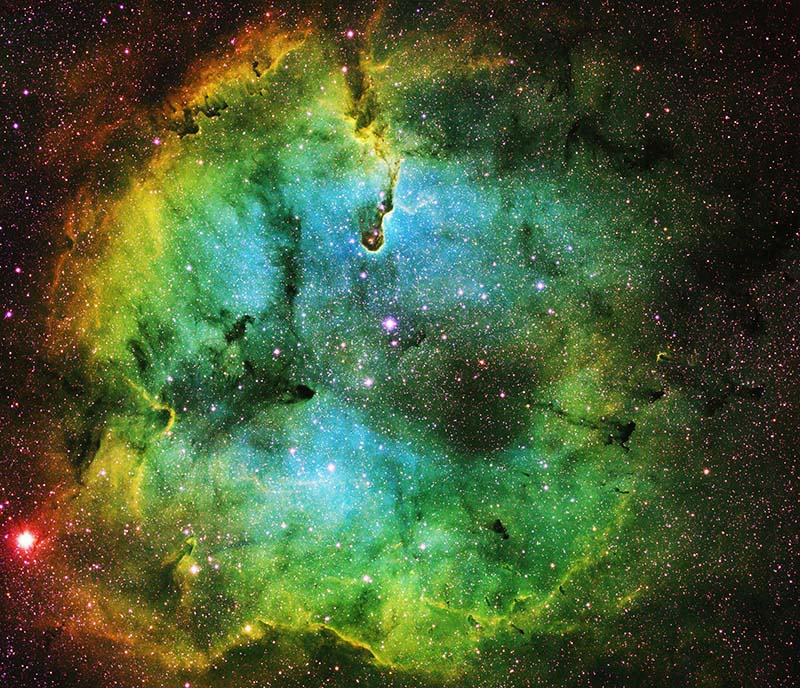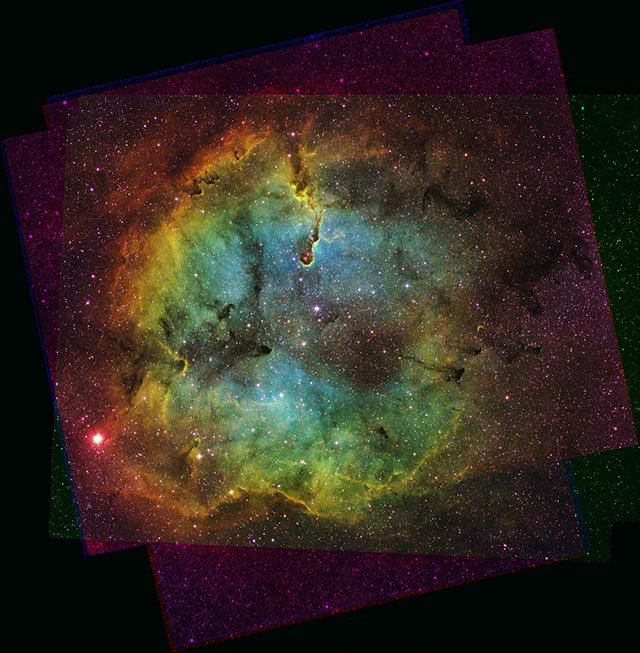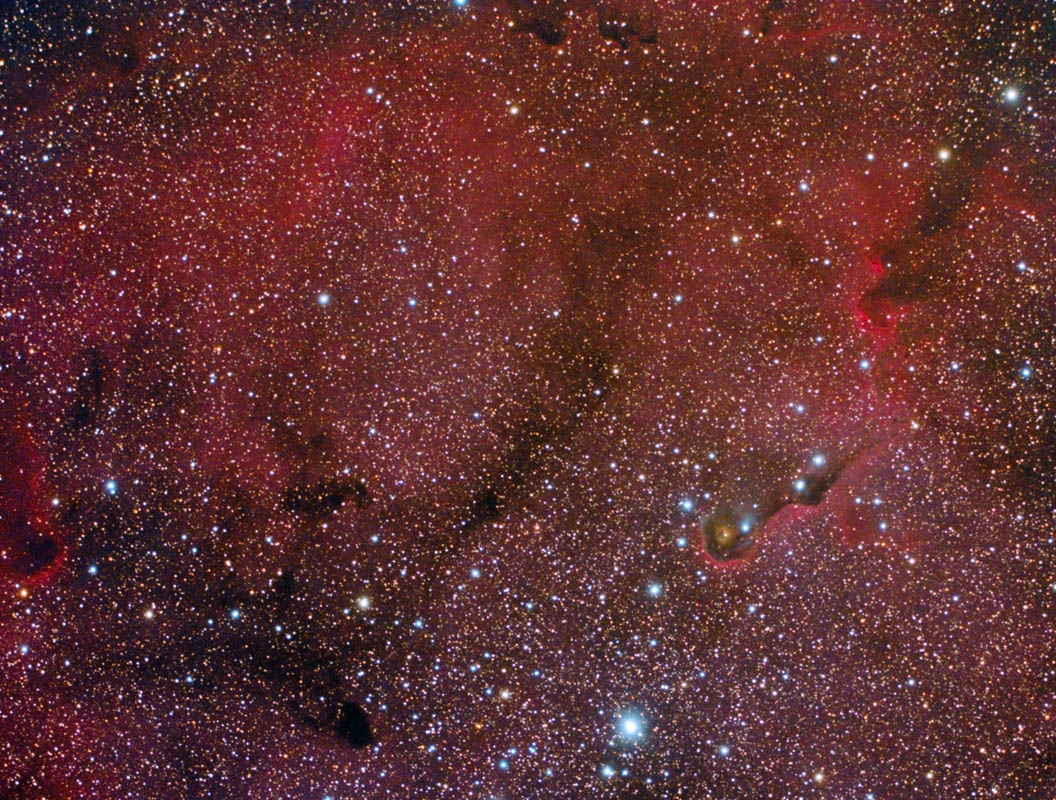
IC 1396 - 16 hrs - Hubble Palette
A wider view of this area is shown on my Cepheus wide-field picture page here

This star forming region in Cepheus is about 3000 light years from earth and features some very cool dark nebulae. The Elephant Trunk area is bottom-center and designated VdB 142.
This image consists of 16 hours total exposure through narrowband filters: 55 * 5 min H-alpha (green), 63 * 5 min Oxygen (OIII) (blue), and 70 * 5 min Sulfur (SII) (red). Imaging took place during the Fall of 2013 and 2014 at the Starry Nights B&B.
Equipment: SBIG ST-8300m monochrome camera, narrowband filters, and the Takahashi FSQ-85 telescope with reducer riding on the AP 900GTO mount from multiple nights of imaging. The H-a component is from the image shown and described further down the page. My image processing techniques are discussed here.

This was my first cut narrowband image; compare with the version at the top of the page. The Elephant Trunk area is top-center and designated VdB 142. Herschel's Garnet Star is relatively bright at mag 4.23 on the lower left of this frame.
This rough cut image consists of 16 hours total exposure through narrowband filters: 55 * 5 min H-alpha, 63 * 5 min Oxygen (OIII), and 70 * 5 min Sulfur (SII). Equipment: SBIG ST-8300m monochrome camera, narrowband filters, and the Takahashi FSQ-85 telescope with reducer riding on the AP 900GTO mount from multiple nights of imaging. The H-a component is from the image shown and described below.

This star forming region in Cepheus is about 3000 light years from earth and features some very cool dark nebulae. The Elephant Trunk area is top-center and designated VdB 142. Herschel's Garnet Star is relatively bright at mag 4.23 on the lower left of the frame, though obviously you can't see the red in this monochrome image.
Dark Nebula Notes: Barnard 365 is above and right of the trunk, Barnard 160 is the larger area below that, and Barnard 162 the next one down. Barnard 163 is to the left and looks like a frog to me. Barnard 367 is the dark blot below and to the left. Barnard 161 is the prominent dark tower mid-left, pointing to the right. There are a ton of Lynd's Dark Nebulae here, this is a partial list starting at the top and generally going clockwise: 1093, 1098, 1085, 1087, 1090, 1099, 1092, 1088, 1101, 1095, 1103, 1104, 1106, 1113, 1118, 1116, 1130, 1129, 1130, 1124, 1121, 1111, 1110, 1112, 1117, 1123, 1126, 1127, 1128, 1116
Image Details: The above features 59*5 minute exposures over two nights with the H-alpha filter in the Fall of 2013. That's a total of about 5 hours during "so-so" conditions for most of the time. The images were captured and processed via my typical image processing methods described here. Equipment: SBIG ST-8300 CCD camera with the FW8-8300 filter wheel, Astrodon narrowband 36mm filters, the Takahashi FSQ-85 telescope with reducer, and AP 900GTO mount.

Just for fun, the above image shows you the image stack that went into the final narrowband images. The colored outlying areas where the source frames didn't line up. Red is SII, green is H-alpha, and blue is OIII. Purple is where the red & blue overlap without any green. The black area was added by Registar as it registered each of the component images so as to get a rectangular result.

This is a star forming area around 3000 light years from Earth. Note the dark dust clouds. Dark Nebula Barnard 161 (B161) is on the mid-lower left, along with LDN 1110, 1112, 1124, 1121, 1117, and several more. Image composed of 18 * 4 = 72 minutes exposure using Takahashi TOA 130 Telescope (a 5" APO refractor telescope) with the reducer, AP 900GTO mount, QHY8 CCD Camera. Other pictures from the camera are are here. Images processed using my Astronomy Image Processing Workflow. Compare with my older DSLR image later on this page.

34*4 minutes = just over two hours total exposure with a Nikon 55mm lens on my modified Canon 20Da DSLR. Dark Nebula Barnard 169 is visible below IC 1396; see this in the telescope shot on the Dark Nebula Page. Sharpless SH2-129 (SH-129) glows above left. SH-132 is below right, SH-134 is to the left of that. There are many other dark and bright nebulae in the frame. This image is from the: December 2010 Astronomy Pictures My notes say: Barnard 169 is the dark area below right while Barnard 160 is the most prominent dust lane above.

DSLR Image Info:
Approximately 25x4 minute exposures =~ 100 minutes total, ISO800
Canon EOS 20Da (unmodified), Takahashi TOA 130 (a 5" APO refractor), Losmandy G-11 mount.
Images from NHAC Neal dark sky observing site, 10/29/2005, ambient temp about 45 degrees at the end of the session
SBIG STV autoguider using Celestron ST-80 guidescope
Combined in Registar, No darks, lights, or flats
Compare with an older Astronomy Picture of the day image here. | |
| |
|
|
|
| Astronomy Features: Some of my best stuff | Messier Object Astrophotography Page | Nebula Page |
Copyright © Dick Locke. All Rights Reserved.
Contact and Image Use Information